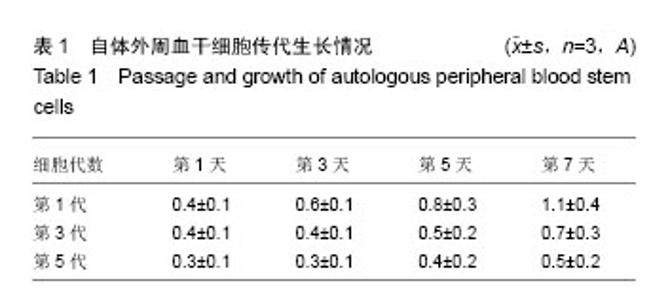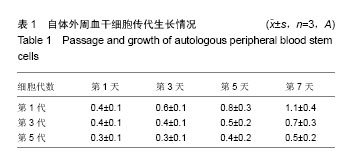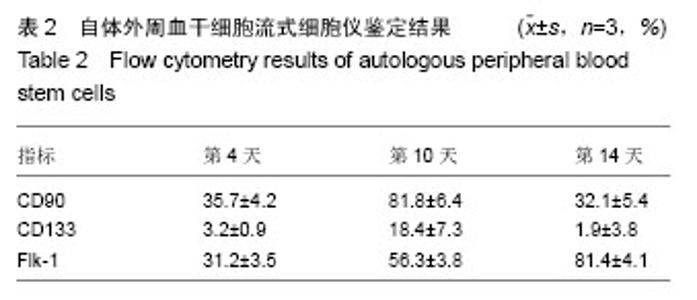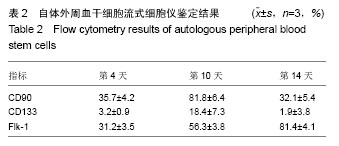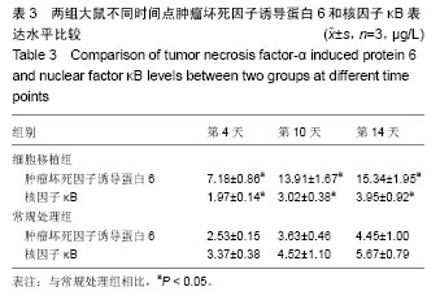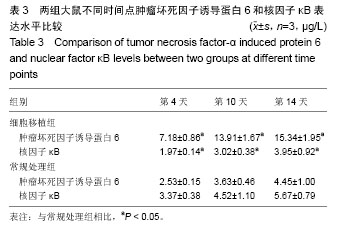Chinese Journal of Tissue Engineering Research ›› 2017, Vol. 21 ›› Issue (9): 1402-1407.doi: 10.3969/j.issn.2095-4344.2017.09.017
Previous Articles Next Articles
Immunological impact of autologous peripheral blood stem cell infusion on lung adenocarcinoma
Wang Mei-jiang, Qi Lin
- First People’s Hospital of Zunyi, Third Affiliated Hospital of Zunyi Medical University, Zunyi 563000, Guizhou Province, China
-
Online:2017-03-28Published:2017-03-31 -
About author:Wang Mei-jiang, Attending physician, First People’s Hospital of Zunyi, Third Affiliated Hospital of Zunyi Medical University, Zunyi 563000, Guizhou Province, China -
Supported by:the Scientific Development Plan of Guizhou Provincial Health Department, No. 201503321
CLC Number:
Cite this article
Wang Mei-jiang, Qi Lin. Immunological impact of autologous peripheral blood stem cell infusion on lung adenocarcinoma[J]. Chinese Journal of Tissue Engineering Research, 2017, 21(9): 1402-1407.
share this article
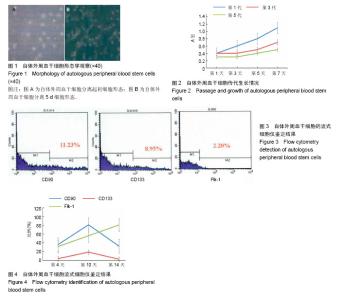
2.1 实验动物数量分析 纳入18只Wistar大鼠进行分组实验,分为2组,全部进行结果分析,中途无脱失。 2.2 自体外周血干细胞形态学观察 从大鼠外周血新分离的单个核细胞呈现出圆形或者椭圆形且体积相对较小,见图1A。自体外周血干细胞培养5 d后细胞生长迅速,圆形细胞开始向两端伸展,并呈现梭形,从而能够形成较小的细胞集落,见图1B。 2.3 自体外周血干细胞传代生长情况 自体外周血干细胞体外诱导培养后先后经历了生长滞缓期、对数增殖期以及生长平台期。自体外周血干细胞第1-3代整体呈现增长趋势,但是随着代数的增加细胞增殖能力出现下降,见表1。 从图2可以看出,自体外周血干细胞总体呈现正增长趋势,且随着代数降低,细胞增殖降低。 2.4 自体外周血干细胞鉴定 原代细胞经过传代扩增,再由流式细胞仪分选纯化的细胞,干细胞因子受体CD90、CD133及Flk-1均有表达,见图3。提示分离培养获得的细胞为自体外周血干细胞。 2.5 流式细胞仪鉴定结果 自体外周血干细胞培养第4,10及14天检测其表面抗原表达结果显示,CD90,CD133呈现先升高后下降趋势,Flk-1呈现上升趋势,见表2。从图4可以看出,自体外周血干细胞CD90、CD133呈现先上升后下降的趋势;ELK-1呈现上升趋势。 2.6 自体外周血干细胞对肺腺癌移植治疗的免疫影响 细胞移植组自体外周血干细胞移植治疗后免疫指标肿瘤坏死因子诱导蛋白6在第4,10,14天显著高于常规处理组 (P < 0.05);核因子κB在第4,10,14天显著低于常规处理组(P < 0.05),见表3。由此看出,自体外周血干细胞能发挥其抗炎和免疫调节作用。"
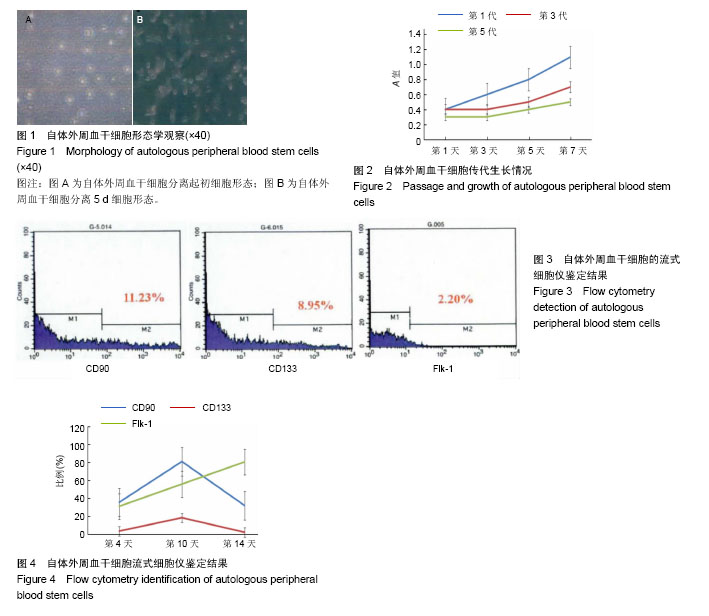
| [1] 朱雄增,张杰.肺腺癌IASLC/ATS/ERS国际多学科分类解读[J].临床与实验病理学杂志,2012,28(3):241-244.[2] Warth A,Muley T,Meister M,et al.The novel histologic International Association for the Study of Lung Cancer / American Thoracic Society / European Respiratory Society classification system of lung adenocarcinoma is a stage-independent predictor of survival.J Clin Oncol. 2012; 30(13): 1438-1446.[3] 刘标,周晓军.非小细胞肺癌个体化治疗的靶向分子检测[J].临床与实验病理学杂志,2012,28(8):831-837.[4] Russell P A,Wainer Z,Wright G M,et al. Does lung adenocarci noma subtype predict patient survival? A clinicopathologic study based on the new International association for the study of lung cancer/American thoracic society/European respiratory society international multidisciplinary lung adenocarcinoma classification.J Thoracic Oncol. 2011;6( 9) : 1496-1504.[5] Warth A,Stenzinger A,von Brünneck A C,et al. Interobserver variability in the application of the novel IASLC/ATS/ERS classifi-cation for pulmonary adenocarcinomas. Eur Respir J. 2012;40(5):1221-1227.[6] 章必成,杨波,刘健,等. 肺腺癌瘤周微淋巴管密度的检测及其预后意义[J].临床肿瘤学杂志,2010,15(11): 978-981.[7] 张力. 脑转移瘤的诊断和治疗[C].中华医学会第五届全国胸部肿瘤及内窥镜学术会议论文汇编,2011.[8] Motoi N,Szoke J,Riely GJ,et al. Lung adenocarcinoma: modification of the 2004 WHO mixed subtype to include the major histologic subtype suggests correlations between papillary and micropapillary adenocarcinoma subtypes,EGFR mutations and gene expression analysis. Am J Surg Pathol. 2008;32(6): 810-827.[9] 刘丽,姜建威.肺腺癌新增分类及研究新进展[J]. 中华临床医师杂志:电子版,2014,8(6):1128-1133.[10] Mc Carroll JA,Gan PP,Liu M,et al. β-Ⅲ-tubulin is a multi functional protein involved in drug sensitivity and tumorigenesis in non-small cell lung cancer. Cancer Res. 2010;70(12): 4995-5003.[11] 石祥宇,庞青松,赵纲,等. 伴微乳头结构肺腺癌的研究进展[J]. 中国肺癌杂志,2015,18(11):701-705.[12] Hung JJ,Yeh YC,Jeng WJ,et al. Predictive value of the international association for the study of lung cancer/American Thoracic Society/ European Respiratory Society classification of lung adenocarcinoma in tumor recurrence and patient survival. J Clin Oncol. 2014;32(22): 2357-2364.[13] 刘雨桃,石远凯,胡兴胜,等.吉非替尼治疗EGFR基因突变状态不明的青年晚期肺腺癌疗效分析[J].中国肺癌杂志,2014,17(5): 401-405.[14] 丁粉干,刘标,张新华,等.不同肺腺癌分级评分系统在I期肺腺癌预后评估中的意义[J].中华病理学杂志,2012,41(3):145-150.[15] Shi Y,Au JS,Thongprasert S,et al. A prospective,molecular epide miologystudy of EGFR mutations in Asian patients with advanced non -small - celllung cancer of adenocarcinoma histology(PIONEER). J Thorac Oncol. 2014;9(2):154 -162.[16] 冯瑞娥.最新国际肺腺癌多学科分类中的病理分类及其临床意义[J].中华结核和呼吸杂志,2012,35(2):95-96.[17] 金鑫,赵绍宏,高洁,等.纯磨玻璃密度肺腺癌病理分类及影像表现特点分析[J].中华放射学杂志,2014,48(4):283-287.[18] Backos DS,Franklin CC,Reigan P. The role of glutathione in brain tumor drug resistance. Bio Chem Pharmacol. 2012; 83(8): 1005-1012.[19] 周晓军,刘摇标.解读2011年IASLC/ATS/ERS肺腺癌国际多学科分类[J].临床与实验病理学杂志,2011,27(8):801-805.[20] 刘颖汇,朱彦君,郭延林,等.肺腺癌中C/EBPα、MVD表达的临床意义及相关性分析[J].临床肺科杂志,2013,18(11):2057-2059.[21] Fujikawa Y,Urano Y,Komatsu T,et al. Design and synthesis of highly sensitive fluorogenic substrates for glutathione S-transferase and application for activity imaging in living cells. Am Chem Soc. 2008;130(44): 14533-14543.[22] 王凯,李晓军,陈芳芳,等. ID3 蛋白在肺腺癌中的表达及临床病理学意义[J].临床检验杂志,2011,29(2): 118-120.[23] Citti A,Boldrini R,lnserra A,et al. Expression of multidrug resistance-associated proteins in paediatric soft tissue sarcomas before and after chemotherapy.Oncol. 2012;41(1): 117-124.[24] Cao Y,Zhang L,Kamimura Y,et al. B7-H1 over-expression regulates epithelial-mesenchymal transition and accelerates carcinogenesis in skin. Cancer Res.2011;71(4): 1235-1243.[25] 史妍婷,井欢,王莹,等.补中益气汤含药血清逆转A549/DDP的顺铂耐药及对mTOR表达的影响[J].中国实验方剂学杂志,2013, 19(9):215-219.[26] 季旭明,欧阳兵,吴智春,等.温下方含药血清诱导A549/DDP细胞凋亡及对Bcl-2,Bax,p53蛋白表达的影响[J].中国实验方剂学杂志,2011,17(12):123-126.[27] Ye MX,Zhao YL, Li Y, et al. Curcumin reverses cis-platin resistance and promotes human lung adenocarcinoma A549 / DDP cell apoptosis through HIF-1α and caspase-3 mechanisms. Phytomedicine. 2012;19( /9): 779-787.[28] 张莹,贾英杰,李小江,等.消岩汤对耐顺铂人肺腺癌A549/DDP细胞多药耐药基因调控作用的研究[J].药物评价研究,2014,37(6): 507-510.[29] 张继新,崔力方,周全,等.肺腺癌转移至胸膜孤立性纤维性肿瘤临床病理观察[J].诊断病理学杂志,2014,21(3):145-148.[30] 马云帆,范梦颖,陈克能.肺鳞癌与肺腺癌的免疫组化指标的诊断及预后意义[J].中国肺癌杂志,2014,17(6):506-510.[31] 俎云芬,王熙才,刘馨,等.甲状腺转录因子在宣威肺腺癌中的表达及临床意义[J].中国肺癌杂志,2013,16(3):131-137.[32] 王艳芬,刘标,徐艳,等.窖蛋白-1表达与肺腺癌临床病理特征和预后的关系[J].中华病理学杂志,2014,43(4):251-255.[33] 张莹,贾英杰,李小江,等.注射用黄芪多糖对耐顺铂人肺腺癌细胞A549/DDP耐药逆转作用研究[J].药物评价研究,2012,35(6): 417-419.[34] Kim TJ,Goo JM,Lee KW,et al. Clinical,pathological and thin-section CT features of persistent multiple ground glass opacity nodules: comparison with solitary ground-glass opacity nodule. Lung Cancer. 2009;64(2):171-178.[35] Eisenberg RL,Bankier AA,Boiselle PM. Compliance with Fleischner Society guidelines for management of small lung nodules: a survey of 834 radiologists. Radiology. 2010;255(1): 218-224.[36] Yoshizawa A,Motoi N,Riely GJ,et al. Impact of proposed IASLC/ATS/ERS classification of lung adenocarcinoma: prognostic subgroups and implications for further revision of staging based on analysis of 514 stage I cases. Mod Pathol. 2011;24 (5):653-664.[37] Sawada E,Nambu A,Motosugi U,et al. Localized mucinous bronchioloalveolar carcinoma of the lung: thin-section computed tomography and fluorodeoxyglucose positron emission tomography findings. Jpn J Radiol. 2010;28(4): 251-258.[38] 唐晓勇,唐迎雪.浙贝母碱对肺癌A549/DDP细胞多药耐药的逆转作用观察及机制探讨[J].山东医药,2012,52(18):4-6.[39] 李泽慧,安超,胡凯文,等.浙贝母总生物碱对人肺腺癌A549/顺铂细胞耐药性的逆转作用[J].中国药理学与毒理学杂志,2013, 27(3):315-320.[40] Kim TJ,Park CM,Goo JM,et al. Is there a role for FDG PET in the management of lung cancer manifesting predominantly as ground-glass opacity? AJR Am J Roentgenol.2012;198(1): 83-88.[41] Selle F, Gligorov J, Soares DG, et al. [High-dose chemotherapy as a strategy to overcome drug resistance in solid tumors].Bull Cancer. 2016;103(10):861-868. [42] Buryk MA, Picarsic JL, Creary SE, et al. Identification of Unique, Heterozygous Germline Mutation, STK11 (p.F354L), in a Child with an Encapsulated Follicular Variant of Papillary Thyroid Carcinoma within Six Months of Completing Treatment for Neuroblastoma. Pediatr Dev Pathol. 2015;18(4): 318-323. [43] Terunuma H. Autologous Immune Enhancement Therapy for Cancer - Our experience since 2004. J Stem Cells Regen Med. 2012;8(3):205-206.[44] Taniguchi A, Takigawa N, Hotta K, et al. [A relapse of small-cell lung cancer ten years after concomitant chemoradiotherapy followed by high-dose chemotherapy with autologous peripheral blood stem cell transfusion]. Nihon Kokyuki Gakkai Zasshi. 2011;49(9):697-701. [45] Terashita S, Hirano K, Hirai T, et al.[Successful treatment of small cell lung cancer with secondary immune thrombocytopenic purpura]. Nihon Kokyuki Gakkai Zasshi. 2009;47(11):1036-1040. [46] Hah JO. Intensive chemotherapy with autologous PBSCT for advanced adrenocortical carcinoma in a child. J Pediatr Hematol Oncol. 2008;30(4):332-334. [47] Stemmer SM, Hardan I, Brenner HJ, et al. High-dose chemotherapy and autologous stem cell transplant in women with de novo chemosensitive metastatic breast cancer. Am J Clin Oncol. 2004;27(3):250-255.[48] Hotta K, Ueoka H, Kiura K, et al. Successful treatment of limited disease-small cell lung cancer with multimodality treatment consisting of concurrent chemoradiotherapy, high-dose chemotherapy with autologous peripheral blood stem cell transplantation and surgical resection. Intern Med. 2003;42(12):1223-1227.[49] Ziske C, Gorschlüter M, Mey U, et al. Sequential high-dose chemotherapy with autologous stem cell support in patients with limited-stage small cell lung cancer. Anticancer Res. 2002;22(6B):3723-3726. |
| [1] | Yao Xiaoling, Peng Jiancheng, Xu Yuerong, Yang Zhidong, Zhang Shuncong. Variable-angle zero-notch anterior interbody fusion system in the treatment of cervical spondylotic myelopathy: 30-month follow-up [J]. Chinese Journal of Tissue Engineering Research, 2022, 26(9): 1377-1382. |
| [2] | Zhang Jinglin, Leng Min, Zhu Boheng, Wang Hong. Mechanism and application of stem cell-derived exosomes in promoting diabetic wound healing [J]. Chinese Journal of Tissue Engineering Research, 2022, 26(7): 1113-1118. |
| [3] | An Weizheng, He Xiao, Ren Shuai, Liu Jianyu. Potential of muscle-derived stem cells in peripheral nerve regeneration [J]. Chinese Journal of Tissue Engineering Research, 2022, 26(7): 1130-1136. |
| [4] | He Yunying, Li Lingjie, Zhang Shuqi, Li Yuzhou, Yang Sheng, Ji Ping. Method of constructing cell spheroids based on agarose and polyacrylic molds [J]. Chinese Journal of Tissue Engineering Research, 2022, 26(4): 553-559. |
| [5] | He Guanyu, Xu Baoshan, Du Lilong, Zhang Tongxing, Huo Zhenxin, Shen Li. Biomimetic orientated microchannel annulus fibrosus scaffold constructed by silk fibroin [J]. Chinese Journal of Tissue Engineering Research, 2022, 26(4): 560-566. |
| [6] | Chen Xiaoxu, Luo Yaxin, Bi Haoran, Yang Kun. Preparation and application of acellular scaffold in tissue engineering and regenerative medicine [J]. Chinese Journal of Tissue Engineering Research, 2022, 26(4): 591-596. |
| [7] | Kang Kunlong, Wang Xintao. Research hotspot of biological scaffold materials promoting osteogenic differentiation of bone marrow mesenchymal stem cells [J]. Chinese Journal of Tissue Engineering Research, 2022, 26(4): 597-603. |
| [8] | Shen Jiahua, Fu Yong. Application of graphene-based nanomaterials in stem cells [J]. Chinese Journal of Tissue Engineering Research, 2022, 26(4): 604-609. |
| [9] | Zhang Tong, Cai Jinchi, Yuan Zhifa, Zhao Haiyan, Han Xingwen, Wang Wenji. Hyaluronic acid-based composite hydrogel in cartilage injury caused by osteoarthritis: application and mechanism [J]. Chinese Journal of Tissue Engineering Research, 2022, 26(4): 617-625. |
| [10] | Li Hui, Chen Lianglong. Application and characteristics of bone graft materials in the treatment of spinal tuberculosis [J]. Chinese Journal of Tissue Engineering Research, 2022, 26(4): 626-630. |
| [11] | Gao Cangjian, Yang Zhen, Liu Shuyun, Li Hao, Fu Liwei, Zhao Tianyuan, Chen Wei, Liao Zhiyao, Li Pinxue, Sui Xiang, Guo Quanyi. Electrospinning for rotator cuff repair [J]. Chinese Journal of Tissue Engineering Research, 2022, 26(4): 637-642. |
| [12] | Guan Jian, Jia Yanfei, Zhang Baoxin , Zhao Guozhong. Application of 4D bioprinting in tissue engineering [J]. Chinese Journal of Tissue Engineering Research, 2022, 26(3): 446-455. |
| [13] | Huang Bo, Chen Mingxue, Peng Liqing, Luo Xujiang, Li Huo, Wang Hao, Tian Qinyu, Lu Xiaobo, Liu Shuyun, Guo Quanyi . Fabrication and biocompatibility of injectable gelatin-methacryloyl/cartilage-derived matrix particles composite hydrogel scaffold [J]. Chinese Journal of Tissue Engineering Research, 2022, 10(16): 2600-2606. |
| [14] | Liu Jiali, Suo Hairui, Yang Han, Wang Ling, Xu Mingen. Influence of lay-down angles on mechanical properties of three-dimensional printed polycaprolactone scaffolds [J]. Chinese Journal of Tissue Engineering Research, 2022, 10(16): 2612-2617. |
| [15] | Fang Xiaoyang, Tang Tian, Wang Nan, Qian Yuzhang, Xie Lin. Repair and regenerative therapies of the annulus fibrosus [J]. Chinese Journal of Tissue Engineering Research, 2022, 26(10): 1582-1587. |
| Viewed | ||||||
|
Full text |
|
|||||
|
Abstract |
|
|||||
